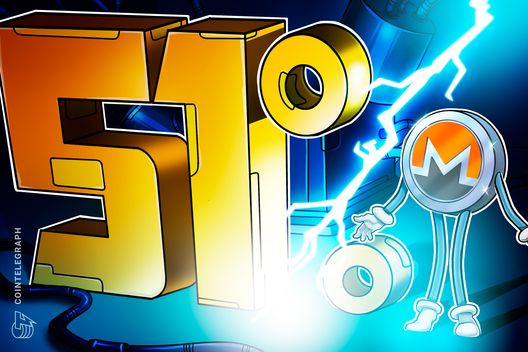
69 Unternehmen halten zusammen über 4,1 Millionen Ethereum (ETH) im Wert von rund 17,3 Milliarden US-Dollar. An der Spitze stehen Bitmine Immersion Tech und SharpLink Gaming.

Finanzmittel Info + Krypto + Geld + Gold
Krypto minen, NFT minten, Gold schürfen und Geld drucken

69 Unternehmen halten zusammen über 4,1 Millionen Ethereum (ETH) im Wert von rund 17,3 Milliarden US-Dollar. An der Spitze stehen Bitmine Immersion Tech und SharpLink Gaming.

MetaMask startet mit MetaMask USD (mUSD) den ersten Stablecoin einer non custodial Wallet. Der digitale Dollar ist direkt in MetaMask integriert, an den US-Dollar gebunden und soll sowohl im DeFi-Bereich als auch für Zahlungen im Alltag eingesetzt werden.

Monero (XMR) könnte bald entscheidende Veränderungen an seinem PoW-Konsensverfahren erleben, um sich gegen zukünftige Angriffe abzusichern.
World Liberty Financial has minted $205 million worth of its USD1 stablecoin shortly after a speech by Federal Reserve Governor Christopher Waller that praised the role of dollar-backed digital assets.
🚨 We just minted $205,000,000 of USD1 for the WLFI Treasury🚨
The fastest-growing stablecoin of all time continues to scale. Backed 1:1 by USD and U.S. Treasuries. Transparent. Reliable. Built for the future of global finance.
$USD1 ☝️| $WLFI 🦅
— WLFI (@worldlibertyfi) August 20, 2025
The move lifted USD1’s supply to a record $2.4 billion, cementing its place as the world’s sixth-largest stablecoin by market capitalisation.
Waller’s remarks at a Wyoming blockchain conference marked one of the strongest endorsements of stablecoins from a sitting Fed governor.
He said the tokens could extend the dollar’s influence globally and improve both retail and cross-border payments.
Waller’s comments, combined with the recent passage of the GENIUS Act, are being seen as a turning point in US policy toward stablecoins.
Hours after the speech, World Liberty Financial announced the $205 million mint, underscoring how closely the project is tying its growth to regulatory signals.
The new mint added more than 9% to USD1’s total supply and propelled the Trump-backed venture to new financial heights.
The mint of $205 million worth of USD1 stablecoins came just as Coinbase added USD1 to its official “roadmap,” a precursor to a full listing on one of the world’s largest cryptocurrency exchanges.
While Coinbase has not yet confirmed a launch date, it said the final step would depend on sufficient liquidity support and technical readiness.
Eric Trump, who is part of the leadership team at World Liberty Financial, has already announced the expected listing, describing it as a sign of trust and validation for the stablecoin.
USD1 is officially on @Coinbase!!!
More @worldlibertyfi news to come very soon! https://t.co/GaDxpHAlH3
— Eric Trump (@EricTrump) August 21, 2025
For the project, gaining access to Coinbase’s vast user base could be the single most important development in accelerating mainstream adoption.
Since its launch in April, the USD1 stablecoin has attracted heavyweight backers.
A $30 million investment came from blockchain entrepreneur Justin Sun, while an Abu Dhabi-linked fund contributed $2 billion to help close a major deal with Binance.
The scale of these commitments has helped USD1 rise faster than almost any other stablecoin, giving it a strong foothold in an increasingly crowded sector.
World Liberty’s treasury holdings have also reached record highs, with nearly $550 million in assets.
A significant share of this sits in USD1 itself, while other positions include Aave’s USDT instruments and more than 19,000 ether.

The Trump family venture has also been steadily accumulating Ethereum (ETH), signalling its ambition to establish deep roots in decentralised finance.
World Liberty Financial is also pushing adoption through direct incentives.
Earlier this year, it airdropped USD1 to early supporters and has since launched a points program to reward users for holding, trading, and staking the stablecoin.
Plans are in place to expand these rewards to DeFi protocols and through a mobile app, creating a loyalty framework uncommon in the stablecoin market.
Such strategies have already translated into tangible utility. USD1 has been used in the settlement of a $2 billion investment in Binance and in proceeds from Bullish Exchange’s IPO.
These transactions highlight how the token is moving beyond theory into real-world institutional use.
With Coinbase preparing to open its doors, World Liberty Financial is positioned to push the USD1 stablecoin into the mainstream.
Backed by billions in institutional money, supported by regulatory momentum, and marketed with political clout, the stablecoin is emerging as one of the most closely watched experiments in the digital asset space.
The post Coinbase to list World Liberty’s USD1 stablecoin appeared first on CoinJournal.
An old Bitcoin (BTC) whale has moved millions into Ethereum (ETH), marking one of the largest visible portfolio shifts this quarter.
Blockchain data shows the whale deposited $76 million worth of BTC into Hyperliquid, sold it, and then opened leveraged long positions in ETH across multiple wallets.
This transition comes at a time when Ethereum is outperforming Bitcoin, both in returns and institutional inflows, a trend some are calling the start of an “Ethereum season.”
The move also coincides with surging ETH exchange-traded fund (ETF) inflows and growing treasury allocations to altcoins.
According to blockchain analytics firm Lookonchain, the whale originally acquired 14,837 BTC seven years ago from HTX and Binance at an average cost of $7,242 per coin.
That purchase, worth $107.5 million at the time, has since grown to more than $1.6 billion.
Recent transactions show the whale deposited 670.1 BTC, valued at $76 million, into the decentralised trading platform Hyperliquid.
Following the sale, they initiated long positions worth 68,130 ETH (around $295 million) across four wallets.
Most trades were executed with leverage of up to 10x, amplifying potential gains or losses.
Latest HypurrScan data revealed that all of the whale’s wallets are now facing unrealised losses totalling $1.8 million.
Despite that, the large-scale diversification highlights a clear shift towards ETH during a period when its performance is outpacing BTC.
Market data from Coinglass shows ETH has delivered a 71.91% return so far in the third quarter, compared to just 6.28% for BTC.
Ethereum’s gains have pushed analysts to identify the current period as “Ethereum season,” where capital is increasingly flowing into ETH instead of Bitcoin.
The momentum has been mirrored in market activity, with Ethereum consistently outpacing Bitcoin in daily returns since the start of the quarter.
Institutional interest in Ethereum has risen sharply. Corporate purchases of Bitcoin for treasury reserves have declined, with just 2.8 companies per day adding BTC to their holdings. By contrast, Ethereum is seeing sustained inflows.
The Strategic ETH Reserve website reported that ETH holdings by institutional entities rose from $6 billion to $17 billion in the past month, representing an 183% increase.
This accumulation points to confidence in Ethereum’s market trajectory and its positioning in the broader crypto cycle.
The whale’s leveraged entry into ETH aligns with this wider trend, suggesting individual and institutional strategies are converging on Ethereum as the asset leading the altcoin phase of the cycle.
Ethereum’s surge is widely viewed as part of the broader “altseason” cycle. In this framework, capital first flows into Bitcoin, then Ethereum, and eventually spreads across other altcoins before a peak.
With ETH already outperforming BTC in both Q2 and Q3, and institutional investment accelerating, analysts suggest the market may now be entering the second phase of the altcoin cycle.
The whale’s move to convert part of its BTC into ETH reflects this trend, with its $76 million bet highlighting how long-term holders are adapting to market shifts.
The post Bitcoin whale shifts $76m into Ethereum with leveraged bets amid ‘Ethereum season’ appeared first on CoinJournal.